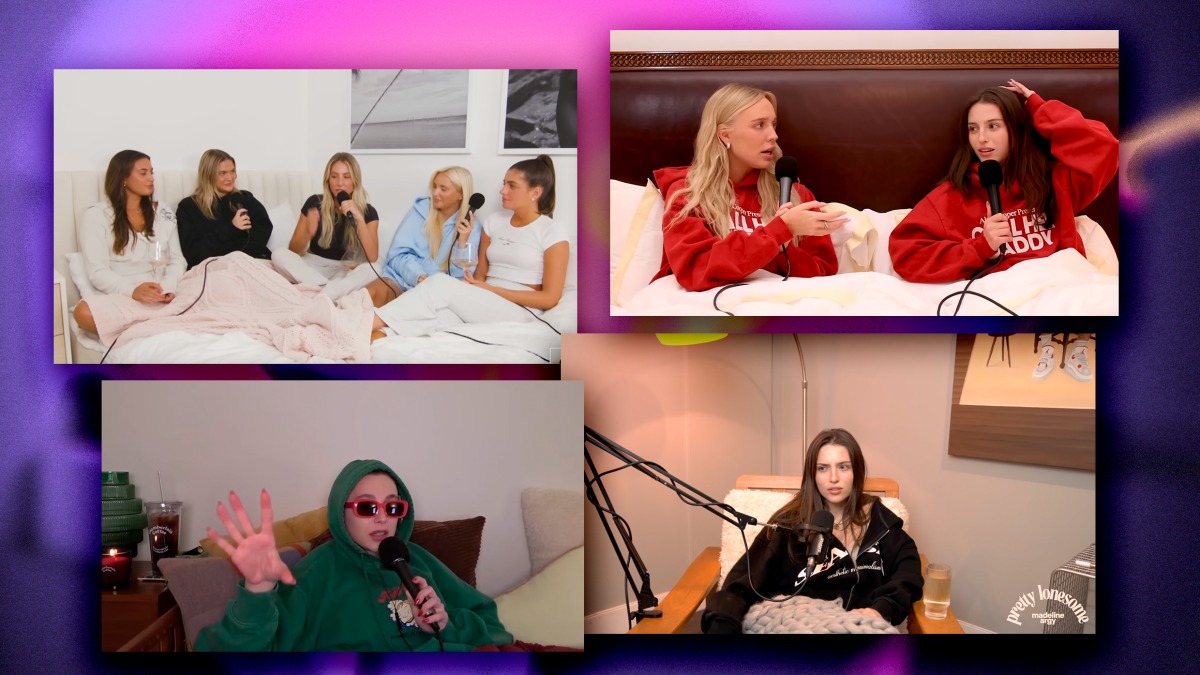- | 9:00 am
Why Gen Z’s biggest podcasters are working from bed
From Emma to Alix, Gen Z creators have turned the bed into a set, and their listeners love them more for it.

Linda Evangalista, the iconic ’90s supermodel, once famously said she wouldn’t get out of bed for less than $10,000 a day. (Props to her.) Now, a new generation of young media personalities are finding they don’t have to leave the bed at all to make bank. In fact, for some, the bed has become the broadcast set of choice—and a strategy to connect with audiences in a whole new way.
Social media has given people access to the most intimate spaces of friends and strangers alike. Lived-in living rooms, messy car interiors, shared bedrooms: what’s mine is yours—and Spotify’s, and TikTok’s, and YouTube’s. Podcasters in the relationship and personal advice genres can be found mic’d up and sitting on an unmade bed surrounded by snacks, or under a mound of blankets, ready to spill all about the discomforts of life from the comfort of their own home (or, at least, sets that look like it).
All three shows under podcaster Alex Cooper’s newly launched Unwell network—Call Her Daddy, Hot Mess, and Pretty Lonesome—channel this in some capacity. Take, for example, the first episode of Alix Earle’s show, Hot Mess, where the host logs on from her perfectly unmade bed, surrounded by friends, to discuss whether or not the man she’s dating is her boyfriend. Or Cooper’s Call Her Daddy, where she’ll occasionally shoot from hotel beds when she’s not in her typical living room set. Sometimes, hosts will be in a cozy armchair, swaddled in macro knit blankets. Wherever they are, this new generation of creators is going to be cozy.

Cooper, who with her husband Matt Kaplan founded the media company Trending and secured a three-year, $60 million Spotify deal in 2021, could have a gold-plated bedroom set if she wanted to. All of the podcasters mentioned here are well-established and out of reach. Bringing followers into their bed is ultimately a strategic choice.
It’s a choice that creates a visual (if fake) sense of intimacy that’s typically only shared with people a listener is super close with: partners, hungover best friends, and the like, which fits the “extreme candor,” as Cooper’s agency describes it, of the podcast subject matter: women you don’t actually know talking with incredible openness about their relationships and sex lives, breakups and exes, tough personal lessons, mental breakdowns, and lingering hang-ups.
Listeners don’t personally know 29-year-old Cooper, or TikTokers Earl and Madeline Argy (22 and 23 years old respectively), who host the other two podcasts in the Unwell network, but they identify with their first-person confessions. Broadcasting from such a personal space communicates that their brand equates a relatable confidante and friend, and creates an environment in which this feels plausible.
This trend isn’t limited to Cooper’s network of shows, either. Other Gen Z podcasters Bobbi Althoff (remember her interview with Drake?) and YouTuber-coffee company founder-podcaster Emma Chamberlain have both opted to broadcast from the soft landing of a mattress rather than the bright lights and neat, newsy desk sets of podcasts that target other demographics, like The Howard Stern Show. Chamberlain shoots her podcast, Anything Goes, from her bed, sunglasses on and surrounded by throw pillows (products from her coffee line are also in the shot). Scroll through TikTok, and many influencers are following suit.
The adoption of these cozy sets also comes at a time when Spotify is leaning into video podcasts. The strategy, in addition to Cooper’s existing success in the market, seems to be working: Call Her Daddy is listed second on Spotify’s top podcasts list for 2023, and 6th on its daily podcast chart at time of writing, Hot Mess is listed 11th.
THE RISE OF WORKING FROM BED
The way we use the bed as a piece of furniture has been shifting for a while. As early as 2012, the Wall Street Journal reported that 8 in 10 millennials had worked from bed, answering emails from their ever-more-popular smartphones. Next, COVID-19 pandemic quarantines, along with the related rise of videoconference calls and the launch of TikTok, accelerated and then normalized our beds as a multifunctional piece—and letting others, whether family, coworkers, or strangers—see it.
Architectural historian Beatriz Colomina noted the beginnings of this phenomenon early on. Beds “are media platforms, zooming, broadcasting, FaceTiming,” she wrote in April 2020. “Think of all of those connecting with friends and colleagues from bed, all the beds you see in the background of work meetings, socializing, comedy shows, at-home music concerts, etc. No bed is a secret anymore.”
For Gen Z, who came into early adulthood around the pandemic, the secret appeal of the bed has been out for a while. Carly Cannell, director of the BFA interior design program at Parsons, recalls assigning a project requiring students to measure their workspace during peak pandemic. “This was the first time I realized they were doing everything from bed,” Cannell recalls. “In New York especially, you don’t have that much space. So your bed is really your home.”
“Suddenly that became part of who you are, and you were completely immune to seeing someone’s bedroom behind them,” Cannell adds. “The Gen Z generation has had more of a familiarity or comfortable relationship with being in bed, and that casual aspect or connection of being in bed.” This comfortability itself has become a TikTok trend: bedrotting, shorthand for spending a day in bed doing nothing. There’s a broad societal change happening around the bed space, according to Cannell. These podcast sets play into that.
The bed and related personal content is also a soft, safe place to land that serves as a counterbalance to the doomscrolling nature of the current state of news. “The bed becomes a place not only for awareness, comfort, and intimacy but also for slowing down,” says Parsons professor, interior designer, and spatial artist Annabelle Schneider, whose exhibition “Being in Bed” showed at this year’s Art Basel. “It’s a moment where you can also reflect and escape from the world.”
For Gen Z, hosts mic’d up in hoodies and chatting from an unmade bed could also be a refreshing escape from the more buttoned up aesthetic of Instagram, according to Jennifer Grygiel, a professor of communication at Syracuse who focuses on culture, social, and emerging media. “Gen Z survivors of Instagram are ready for sweatpants,” Grygiel says, referring to internal data from Meta that showed the platform’s documented harmful effects on teen girls. “They’re the group determining what their social culture will be for their generation. They’re setting their values. So if we see cis-women sitting on a couch, I would say it speaks to what their culture is, and there’s something maybe healthy about it.”
But the podcasts’ strategy “draws on the most basic theories of parasocial relationships,” says Grygiel, referring to the one-sided sense of familiarity a person can form with a celebrity who doesn’t know they exist. Grygiel describes a parasocial relationship as “a friendship that’s not real. It’s almost like a simulated false reality,” they say.
The relatability and intimacy of these podcasts are the reasons for their appeal, says 21-year-old Syracuse student Ella Nordberg, who has been a regular listener of Emma Chamberlain’s podcast. “For me, I think the bed setting conveys a ‘chill vibe’” she says. “Specifically with Emma’s podcast, the structure feels like a stream of consciousness, like you are sitting on the phone with a friend, or if you are watching it, hanging out with a friend at home chitchatting.”
That feeling of deep familiarity is imperative to the success of these podcasts, whose content is centered around the host’s personal life. Consider a few episodes from the Unwell network of shows: the first episode of Madeline Argy’s Pretty Lonesome is titled “our first date.” She regularly signs off by saying “I love you.” A recent Call Her Daddy episode was titled “My mom found my nudes.” You’ve never met them, but they’re not exactly strangers, either. It’s the not-so-secret secret to these podcasts’ success.
The bed setting suspends disbelief. It lets followers forget that they’re actually listening to a complete stranger reveal carefully calculated details about their lives. It lets them forget that this is actually content with $60 million of investment behind it, and that they are a consumer that’s taking part in a media ecosystem with a $36 billion market cap. It’s a conversation, sure. But one person in the conversation is talking to a camera, and the other passively listening, perhaps in their own bed, washed in the blue light of an iPhone screen.





































